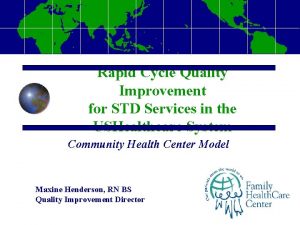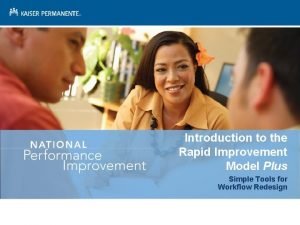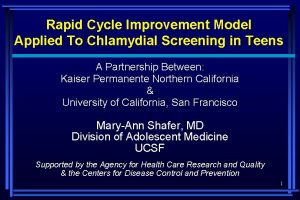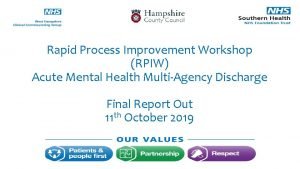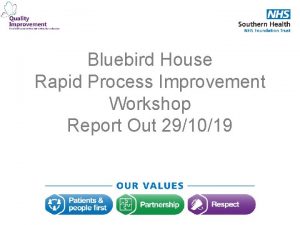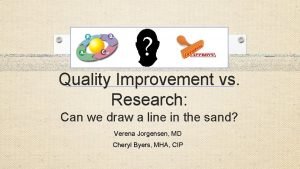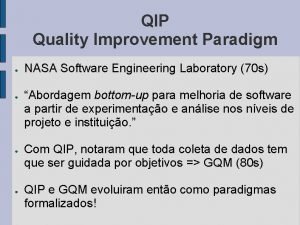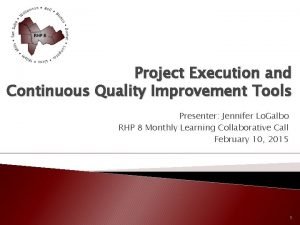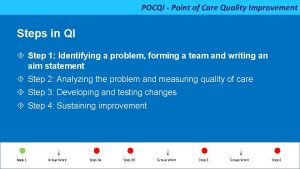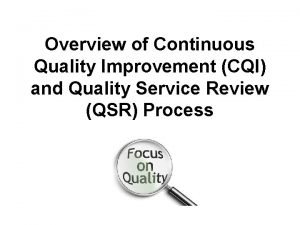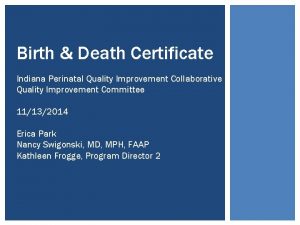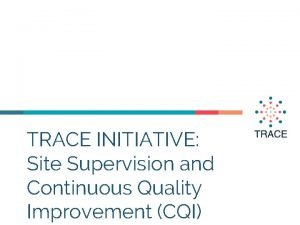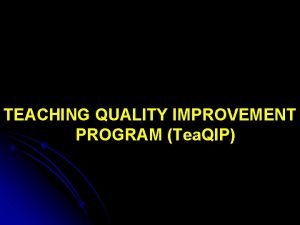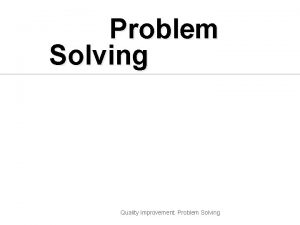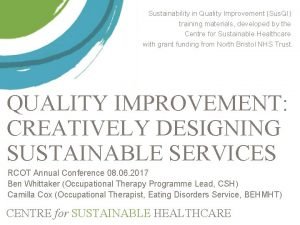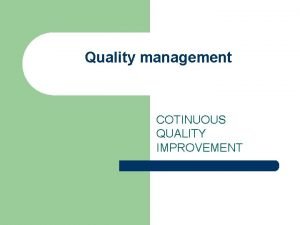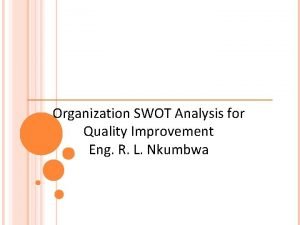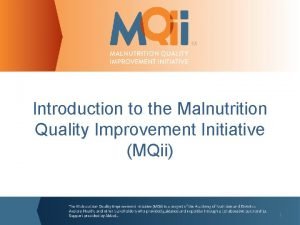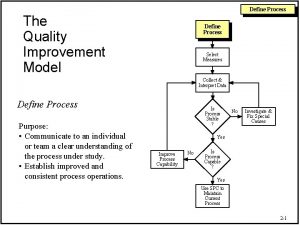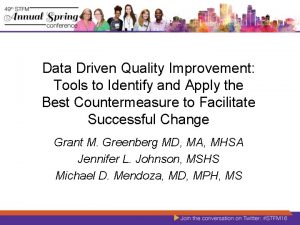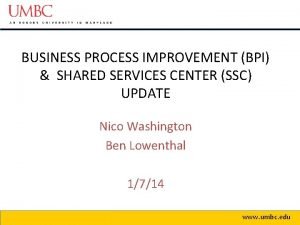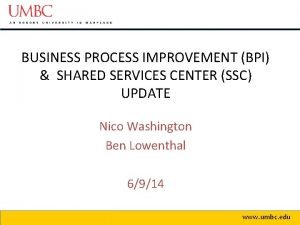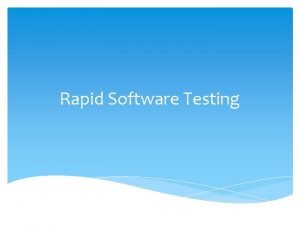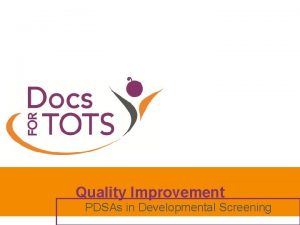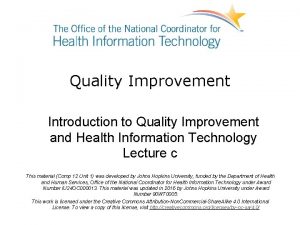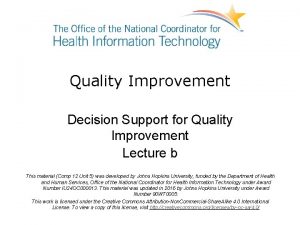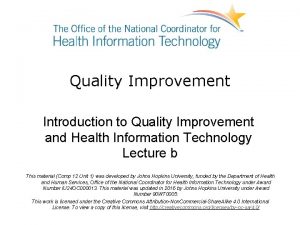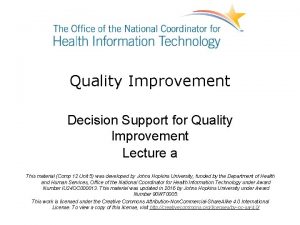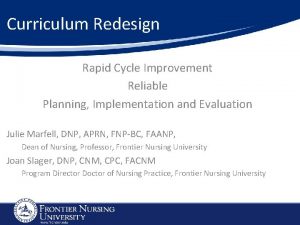Rapid Cycle Quality Improvement for STD Services in





























- Slides: 29

Rapid Cycle Quality Improvement for STD Services in the USHealthcare System Community Health Center Model Maxine Henderson, RN BS Quality Improvement Director

Family Health. Care Center - Fargo Federally qualified 501(c 3) Community Health Center Small border city in rural area of ND/MN Joint Commission Accredited – Ambulatory Care

Services 2 Family Practice Clinic sites 2 Dental Clinics Homeless Health Service Native American Programs Medical Interpreter Service – serves city Concordia College Student Health Service Cass/Clay County jails Serve 20 different cultures Interpret 13 different languages

Patient Demographics: 80% of pts under the age of 45 yrs

Ethnicity

Patient Population Served >11, 000 patients >1900 females 15 -25 years 94% below 200% poverty level 34 % are uninsured 37% receive Medical Assistance

Performance Improvement Rapid Cycle Improvements for Chronic Disease Management Prevention Services Chlamydia Screening

BPHC Collaboratives The (Chronic) Care Model Ed Wagner, MD Mc. Coll Institute – Seattle Model for Improvement PDSA (Plan-Do-Study-Act) Cycles Associates in Process Improvement 4 years

Key Improvements Organization of Health. Care Administrative support • Staff time • Financial resources Improvement in health outcomes becomes part of Strategic Plan Component of new employee/provider orientation

Decision Support Use of Clinical Guidelines • Embedded throughout clinic practice • Part of annual provider competency evaluation • Linked to incentive raises Clear Measurable goals Increased access to expertise • Continual education for providers/clinical staff • Specialists available for consultation

Delivery System Design Forms which trigger compliance with practice standards “Planned visits” Standing orders Multidisciplinary approach Clinical Information Systems Patient tracking and follow-up

Self-Management Support Risk assessments Learning needs assessments Shared decision making – Patient goal setting Improved patient education • Standards of Care – Disease states – Prevention for age group

Community Resources Partnerships with other organizations • Public Health • Red River Dental Access • Extension Services • Local Universities / Schools Grants to support special projects • $$$$ available for prevention activities

Improved Health Outcomes >400 patients with Diabetes Average A 1 c 9. 79 to 7. 69 Average Cholesterol 232 to 186 Average systolic B/P 155 to 137

> 200 patients with Asthma After 4 session Asthma Education Program Understanding of meds 56% to 100% Perform home peak flow 25% to 94% Written Asthma Action Plan Use of spacer 6% to 100% 33% to 87%

Spread Once you learn how to use rapid cycle improvements in all components of The Care Model, it is easy to Spread: Depression Cardiovascular Disease Perinatal Refugee Health

PREVENTION - Current area of Spread Pilot: 5 CHCs – BPHC – CDC – IHI • Healthy Weight Management • Physical Exercise • B/P Screening • Cholesterol Screening • Oral Health • Lead Screening • Immunizations • Chlamydia Screening

Chlamydia & GC Screening - 2003 Total Female patients 15 -25 yrs. - 1906 Pap smear 15 -25 yrs. – 542 (28%) Chlamydia Screening 15 -25 yrs. - 428 79% of those having Paps 8% Positive + (3 pos. gonorrhea)

Chlamydia & GC Screening >26 yrs. – 316 pts. 1% Positive • + (4 pos. gonorrhea)

Confirms…. . Age is the single biggest predictor of Chlamydia infection in our clinic

Opportunity for Improvement Variance: The 72% of 15 -25 year old female patients that were not scheduled for a pap smear at our clinic Unknown: How many of these adolescents were referred to and seen at Public Health for testing

Patients Referred FHC Clinics are in same building as Public Health Dept. at both sites Adolescents who don’t want parents to know, or bill to be sent, are referred to PH Confidential Sliding Fee Scale on adolescent’s income – so usually free or a donation

Public Health Dept. Screenings Chlamydia Screenings – 2003 2, 865 tests done 203 (7. 08%) positive for Chlamydia What % of these were adolescents referred by Family Health. Care Center?

Performance Improvement Plan ü Developed Clinical Guidelines for Management of Chlamydia Infection ü Provider Education Guidelines Clinic Baseline Statistics ü Goal: Increase screening for females 15 -25 yrs. by 100%

ü Expanded Teen Risk Assessment Form ü Made screening affordable MN Teen Program - $15 (exam, pap, screen) • Confidential $9 regular charge for test ü Evaluating need for urine screening ü Improved education materials on Chlamydia ü Set-up monthly tracking process # females – paps – screenings - % positive Adolescent referrals to Public Health

Prevention Collaborative Family Health. Care Center-Fargo PDSA Cycle # 28 Increase Number of Chlamydia Screenings Done with Routine Paps Jan. 2004 PLAN Objective Increase the number of Chlamydia screenings done on female patients 15 -25 years old who are being seen for a routine pap and physical. Prediction We will be able to achieve a >95% screening rate, by doing provider staff education and amking small changes in the supply set-up for routine paps. Plan for test: who, what, when, where Review Clinical Guidelines with provider and nurse who will conduct test Remind provider to include routine screen on all female patients 15 -25 years, and all at-risk females >26 years. Add Gen-Probe Collection Kit and Lab Request Form to room set-up list for routine pap and physical Plan for collection of data: QI Dir. – on Monday afternoon, run test provider’s schedule for next day Mark all routine paps and physicals on patients 15 -25 years Ask test provider’s nurse to mark on the schedule if a Chlamydia screen was done, and return schedule to QI Dir. at end of day.

DO Monday pm - provider’s schedule was run and paps for next day on 15 -25 year old female patients were marked. Tuesday am – huddled with provider and nurse to review schedule. Reminded nurse to put out Gen-Probe swab and lab slip for each scheduled pap that day. Instructed nurse to mark schedule if Chlamydia screen was done along with exam. STUDY By reviewing last year’s screening statistics and the new Clinical Guidelines with the provider, she agreed we missed easy opportunities for screening. 100% of patients (5 patients age 17 -24 years) were screened for Chlamydia during this test. Having the Gen-Probe Collection kit and lab slip laid out reminded the provider to do the test. ACT Wednesday – repeated test with a different provider and nurse: again 100% of targeted patients were screened. Reviewed procedure with all providers and nursing staff, and procedure implemented as a Standard of Practice in our health center.

Barriers to Improvement Lack of patient education materials in many languages Many refugees illiterate – even in primary language Inconsistent adherence to Clinical Guidelines by clinic providers – resistance to change

Resources need for new equipment Increase staff time needed for registry data entry Uninsured patients unable to pay for all tests/services recommended Orientation of new providers and staff
 Rapid cycle quality improvement
Rapid cycle quality improvement Rapid improvement model
Rapid improvement model Rapid improvement model
Rapid improvement model Ana quality assurance model
Ana quality assurance model Compliance vs quality
Compliance vs quality Process improvement workshop agenda
Process improvement workshop agenda Rapid process improvement
Rapid process improvement Rapid process improvement workshop
Rapid process improvement workshop Jhm irb
Jhm irb Qsen evidence based practice examples
Qsen evidence based practice examples Quality improvement paradigm
Quality improvement paradigm Define continuous quality improvement
Define continuous quality improvement Point of care quality improvement
Point of care quality improvement Define continuous quality improvement
Define continuous quality improvement Efmd quality improvement system
Efmd quality improvement system Indiana perinatal quality improvement collaborative
Indiana perinatal quality improvement collaborative Continuous quality improvement program planning worksheet
Continuous quality improvement program planning worksheet Tea quality improvement
Tea quality improvement Xerox problem solving process
Xerox problem solving process Sustainability in quality improvement
Sustainability in quality improvement Cotinuous
Cotinuous Quality improvement
Quality improvement Juran 10 steps to quality improvement
Juran 10 steps to quality improvement Swot analysis for quality
Swot analysis for quality Mqii toolkit
Mqii toolkit Quality improvement
Quality improvement Data driven quality
Data driven quality Quality is free: the art of making quality certain
Quality is free: the art of making quality certain Shared services process improvement
Shared services process improvement Umbc ap credit chart
Umbc ap credit chart
